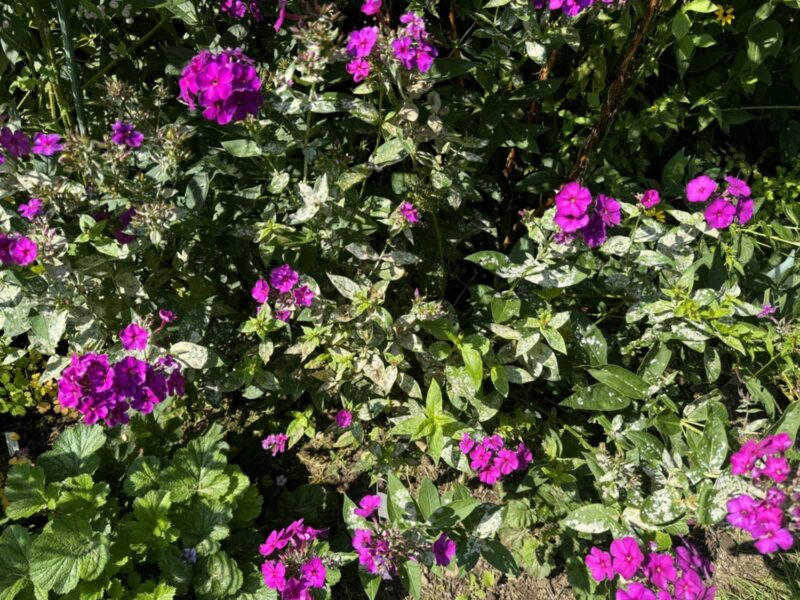

I usually sit on my front porch late in the afternoon so I can watch the hummingbirds at the feeder just a few feet from my favorite porch chair. I spread my gaze across the front of the property viewing the troubled lawn, trees and shrubs and of course my beloved perennials. Our property in its entirety is just under an acre, square, and our house sits right in the center.
To my far right is a long shady border that gets no sun until late morning or early afternoon. It contains some of my woodland plantings, but it’s blocked from my view by a magnificent magnolia just to my right. The magnolia is one of three on the property, and while I love its sensual spring flowers along with its perfumed petals, the tree, once just a stick, is now 25 feet tall and 12 feet wide.
Surprisingly, the magnolia is the second favorite landing spot for the hummingbirds. They can hide among the dense, thick foliage while they preen and keep vigilance on their feeder making sure that interlopers, mostly unwelcome males, are immediately dispatched while the females freely come and go, sipping sugar water from dawn till just past dusk.
But as I adjust my gaze to the distant north corner of the property, I can see the top four feet of another magnolia 60 feet away. The view toward the top of the magnolia starts with the blood-red foliage of a red Japanese maple and beyond that, reaching higher, there’s a two-tone green Japanese maple whose lower foliage is a classic foliage green but closer to the top of the 15-foot tree the foliage is a lighter, almost lime green. These two shades of green continue the foreground red of the Japanese maple for a fascinating color contrast.
The magnolia beyond is in the background, and every summer I remember that this magnolia, only at the top, flowers through the summer. Every few days a multishaded pink-red flower opens, lasts just a day in the summer heat, then disappears. Tomorrow there will be another. I’ve always wondered if I took a cutting of the top of this magnolia and rooted it if I’d have a summer-blooming variety? I may never know.
Directly in front of me, about 50 feet away, is a line of Hibiscus syriacus now in full bloom. These were some of the first things I planted when we bought the house over 20 years ago, and each shrub is now about 10 feet tall and from 6 to 8 feet wide. I make an annual attempt to prune and shape them with the goal being to create an archway between each pair as a small viewscape opening. Others shear this shrub as a hedgerow, and some just let it loose.
These shrub altheas have always been a love-hate relationship for me as I know they are for many gardeners. In the Hamptons, you tend to find them in the communities where you don’t find the privet hedges. They are somewhat unruly and considered woody weeds by many. But they do have many positive traits, not the least of which are their classic hibiscus flowers that I find very sensuous. Two of my specimens have double flowers while the others are single-flowered type. Most are in the Chiffon series.
New flowers open each morning but only last a day or two and then are replaced. All day long the flowers are social and feeding hubs for the hummingbirds and at least three species of butterflies. Several varieties of birds, including catbirds and finches, delight on the insects that live toward the tops of the shrubs. And as the day advances the colors of the flower petals can have subtle to dramatic color changes that range from a light lavender or purple, white and various shades of pink to near red.
It’s also not uncommon to have one shrub with as many as four different colored flowers on the same shrub, or so it appears. What’s really going on though is a great and beautiful display of sexual variation. The flowers are pollen rich, and as the hummers and insects move from flower to flower they carry pollen on their wings, feet and beaks, resulting in some remarkable random crosses whose seed production results in this mash of flower colors.
As the flowers mature they leave behind a somewhat woody seed capsule that browns, opens and drops the seed to the ground at the base of the shrubs. The result is that while five separate varieties of rose of Sharon were originally planted, the plants’ sexual proclivity has resulted in each shrub now having two to four different colors of flowers on the same shrub (from different sprouts at the base) resulting in an ever-changing palette. The two double-flowered varieties tend to be more color stable if you prefer the monotony of sameness.
When the shrub hibiscus are done the perennial varieties nearby begin to flower. I have four varieties in three locations, and each variety has its attributes, but admittedly I’m more enamored by only three of them, Berry Awesome, Cherry Brandy and Brandy Punch, all of which are just flowering now.
Moving to the left I have a very large and old arborvitae that’s about 40 feet tall and half as wide. I’ve developed a semi-circular planting bed on the south side base of the tree with several hydrangeas, lilacs and amsonia edging the bed. Quite accidentally, I seem to have planted two white hydrangeas on one side followed by a magnificent, short (dwarf) blue hydrangea that is probably “Let’s Dance Rhapsody Blue,” then the amsonia.
To the left of the hydrangea is a dwarf Amsonia tabernaemontana (eastern bluestar) followed by a taller standard variety. This leaves a color combination left to right of white to blue to green during the summer. It’s turned out to be quite eye-catching though the Rhapsody Blue really steals the show. It provides a needed color break but also glows and self-highlights early in the day and as the sun passes behind the bed later in the day into early evening.
In the spring and early in the summer, the two varieties of amsonia provide the blue color that the hydrangea offers in the warmer months. But the Amsonia tabernaemontana shouldn’t be written off after it flowers. I think this plant is way underutilized because not only does it have a pleasant flower but once the flowers are finished the habit of this plant makes a nice 20-inch short hedger that hides everything behind it.
Lastly, this week we look to the left about 30 feet from the arborvitae planting, and we’re looking at the long perennial border. Right in the middle of the view is a remarkable but somewhat difficult plant known as Phlox paniculata “Nicky.” This is one of if not my favorite tall garden phlox, but it can also be a curse if you don’t handle it correctly. On stems of 20 to 36 inches, it blooms in July and into August with at least a four-week blooming period. The flower color, an intense, deep magenta-purple, makes it stand out and glow, especially as the sun fades later in the day. It makes great cuts.
Now, while Nicky is touted as being a powdery mildew resistant variety of phlox, I haven’t found this to be true. That’s not a reason to write it off, but grow it with caution. The PM can be managed easily with applications of baking soda and light horticultural oil as soon as the PM appears. Start spraying as soon as you see any hint of the PM and you can easily manage it through the season. Also don’t let the plant crowd itself and thin the stems early in the season. Overhead watering will only exacerbate the PM so make sure it’s not hit by irrigation. Water it by hand.
Next to Nicky I have Heliopsis helianthoides “Burning Hearts” growing. This is one of the perennial sunflowers, but it’s called a false sunflower and bears no resemblance at all to what you image of a sunflower is. My plants emerged in June only to have every single leaf eaten by the rabbits. What was left were stems and stubs.
Undaunted, I built wire cages for each of the three plants (on 1-foot centers) and in just a few weeks they had totally regrown. The foliage is an attractive green with strong hints of bronze. The flowers are about 2 inches across and often open as an intense orange red which then mature into golden orange with red centers.
The flowers are striking and variable in coloration, but that’s part of their appeal. The plants grow from 12 to 15 inches tall but bushy and will fill in nicely when given enough sun. (Some descriptions say it grows to 48 inches, though I’m a bit dubious.) Mine may be bushier than others as they were rabbit pruned. In three years of growing Burning Hearts, I’ve found no disease or insect issues, but if you’ve got rabbits the plants might benefit from some protection until the foliage is fully emerged. From then on, just enjoy.
GARDEN NOTES
Remember that prime grass seed and lawn renovation time is just weeks away, and when done in late August you end up with a great lawn next spring.
Japanese beetles have long been the bane of many gardeners, especially those growing roses and anything in the hibiscus family. But in recent years many of us have seen this insect disappear or be present in very small numbers. I had only 10 this year when five years ago I’d have hundreds. Low numbers this year may be due to the drought last year since the eggs and larvae need wet soil. Another growing theory is that there’s a naturally occurring bacteria that is killing them off. There are still outbreaks though, and the common thread where the outbreaks occur seems to be when the beetles’ favorite plants are grown at the lawn’s edge. This is a bad scenario where it exists as it provides the perfect situation for feeding followed by egg laying in the lawn. Milky spore, once used to manage the beetle in lawns, does not appear to be effective any longer.
 More Posts from Andrew Messinger
More Posts from Andrew Messinger